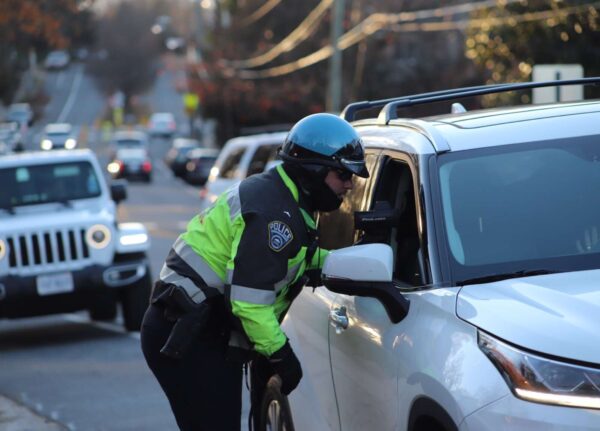
(Updated at 4:10 p.m.) Police issued a traffic ticket every six minutes, on average, during an enforcement effort in front of Nottingham Elementary on Thursday afternoon.
The several block stretch of Little Falls Road near the school, in the Williamsburg neighborhood, has seen three fatal pedestrian crashes since 2014, including an elderly woman who was struck and killed by the driver of an SUV in October. That driver is not facing criminal charges.
Arlington County police conducted yesterday’s high-visibility enforcement as part of its Street Smart road safety campaign.
“During yesterday’s hour-long StreetSmart activation in the 5900 block of Little Falls Road, which coincided with school dismissal, officers issued 8 speeding citations and 2 citations for stop sign violations,” ACPD spokeswoman Ashley Savage tells ARLnow. “Drivers are reminded to slow down, be mindful of pedestrians and obey posted speed limits which change during school zone times and are indicated by flashing yellow lights.”
As part of the @COGStreetSmart campaign, officers conducted high-visibility traffic enforcement in the 5900 block of Little Falls Rd. The campaign aims to identify & change unsafe behavior patterns with the goal of reducing traffic related collisions and injuries on our roadways. pic.twitter.com/MEgOYDDST8
— ArlingtonCountyPD (@ArlingtonVaPD) December 1, 2022
“Officers will continue to conduct periodic random, rotating enforcement in the area with the goal of compliance even when police are not present,” Savage noted. “Additionally, as part of our education efforts, police have deployed a variable message board on Little Falls Road with transportation safety messaging.”
Arlington’s Dept. of Environmental Services added that safety improvements are in the works for the intersection where October’s crash happened.
“In response to the recent tragic crash fatality at the intersection of Little Falls Rd and John Marshall Dr, the Vision Zero Critical Crash team has developed short-term safety improvements and enhancements for this intersection,” the department said in a brief statement. “We plan to install these improvements by the end of the year, weather permitting.”
More on the fall Street Smart campaign in Arlington, below, via an ACPD video.
Unmarked or temporarily marked crosswalks along Langston Blvd are slated to be painted today (Friday), weather permitting.
The repainting activity comes nearly two months after the Virginia Department of Transportation paved Langston Blvd from Washington Blvd to N. Glebe Road, in East Falls Church, and from Military Road to N. Kenmore Street, in Cherrydale, according to a paving map.
VDOT, which manages the road, finished the repaving projects at the start of September, as part of its annual road repaving and repainting schedule.
According to the state transportation department, the lag between paving and painting is not uncommon.
“As the line painting contractors are different than the milling/paving contractors, sometimes schedules don’t line up as smoothly,” VDOT spokeswoman Ellen Kamilakis tells ARLnow.
Arlington County and some residents tell ARLnow they have raised concerns about the lag with state transportation department.
“VDOT is aware of our concerns and are working to complete the markings on Langston Blvd,” Arlington Dept. of Environmental Services spokeswoman Katie O’Brien said.
The repainting comes while pedestrian safety occupies the minds of Arlington County Board members, local advocates and residents. In recent months, drivers struck and killed two pedestrians: one woman near Thomas Jefferson Middle School was killed by an alleged drunk driver and a woman near Nottingham Elementary School was killed in a crash, which police are still investigating.
While VDOT repaves state routes, Arlington County does take advantage of the state’s schedule to consider changes to the streets under its purview through its Resurfacing for Complete Streets program, O’Brien said.
“For roadways maintained by VDOT, Arlington does coordinate with VDOT on improvements,” she said. “For example, this year VDOT will be adding crossing enhancements on Langston Blvd at our request.”
These include high visibility crosswalk markings, advance yield signs and markings, she says.
She added that the county coordinated with the state to “upgrade the two uncontrolled crosswalks at the intersections of Langston Blvd and N. Oakland Street and Langston Blvd and N. Nelson Street, as well as marking all side streets with high-visibility crosswalks instead of standard crosswalks.”
On Langston Blvd between Military Road and N. Kenmore Street, VDOT will be installing bike lane skip marks through intersections, high-visibility crosswalks along side streets and additional directional markings, according to the county’s first annual Vision Zero report, released this spring.
Arlington County is a year and a half into its Vision Zero initiative that aims to eliminate traffic fatalities and serious injuries. Between January 2021 and March 2022, the county updated 238 crosswalks to high-visibility crosswalks, according to the report.
It also “added new warning signage, pavement yield and high visibility crosswalk markings, and other minor improvements at 12 multilane crossing locations,” after a review of multi-lane crossings, per an August newsletter.
Work to rebuild Army Navy Drive through Pentagon City and improve safety and transit along the corridor is officially underway.
This morning, Arlington County and the Northern Virginia Transportation Authority ceremonially broke ground on the long-planned Army Navy Drive “Complete Street” Project, which is intended to make the current multi-lane expanse of Army Navy Drive between S. Joyce Street and 12th Street S. more friendly to pedestrians, cyclists and transit users.
The project includes shortened pedestrian crossings, dedicated transit lanes between S. Joyce Street and S. Hayes Street, planted medians, new traffic signals at five intersections, and in some places, narrowed or reduced vehicle travel lanes. There will be a protected, two-way bicycle lane along the south side of Army Navy Drive.
Work kicks off as the number of workers and residents in the area is projected to significantly increase in the coming years. Amazon is preparing to build the second phase of its HQ2 — known as PenPlace, and which includes the iconic “Helix” building — at the corner of Army Navy Drive and S. Eads Street, while continuing to hire toward its goal of 25,000 employees. Meanwhile, JBG Smith has filed plans to add 1,668 residential units to surface parking lots at the nearby RiverHouse complex.
For the next three weeks, road users will see signs of crews setting up for the Army Navy Drive project, like cones and a construction management trailer, says Mark Dennis, project manager for Arlington’s Dept. of Environmental Services. In mid-November, people will start to see demolition work.
“Both sides of the corridors will have markings and indicators that the entire area is a working construction zone,” Dennis told ARLnow. “There will be slight changes in traffic patterns to accommodate lane shifts that are needed.”
He said drivers will need to pay extra attention to navigate these changes.
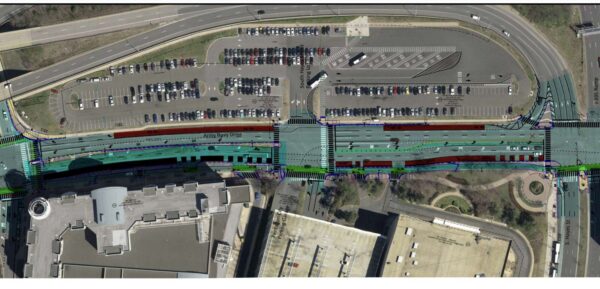
Before scooping ceremonial dirt with gold-colored shovels, local and regional dignitaries celebrated the expected benefits of the project.
Arlington County Board Chair Katie Cristol said the project will make Army Navy Drive safer for pedestrians and cyclists and more convenient for bus riders. It will also slow down drivers, improve air quality and reduce stormwater runoff, she said.
“It’s better for all of us because providing safe, accessible and multimodal transportation is a key part of the economic competitiveness of Pentagon City and Arlington overall,” said Cristol.
NVTA CEO Monica Backmon celebrated the project for “getting people out of their single-occupancy vehicles and giving people options.”
https://twitter.com/NVTAuthority/status/1584554450823544832
The transportation authority said in a press release that it has invested more than $227 million into transportation projects located in Pentagon City, Crystal City and Potomac Yard, known collectively as National Landing.
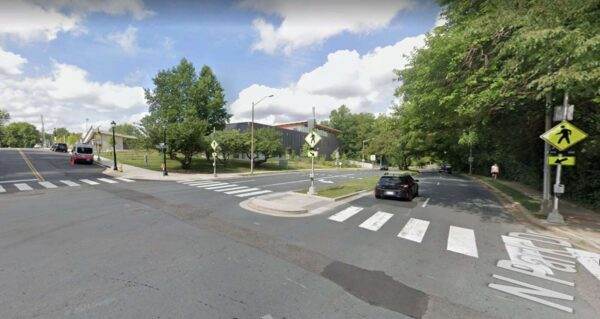
(Updated, 4:55 p.m.) A recent crash has renewed concerns about an intersection near the year-old Lubber Run Community Center.
For years, the intersection of N. Park Drive and N. George Mason Drive in the Arlington Forest neighborhood has been a source of worry for neighbors. The mix of speeding, four lanes, and a lack of a traffic signal have resulted in too many vehicle crashes, residents told ARLnow.
There have been 19 crashes at the intersection dating back to 2017, per data provided to ARLnow by the county’s Department of Environmental Services (DES). That includes one pedestrian-involved crash in 2018. None of the crashes resulted “in severe injury,” DES said.
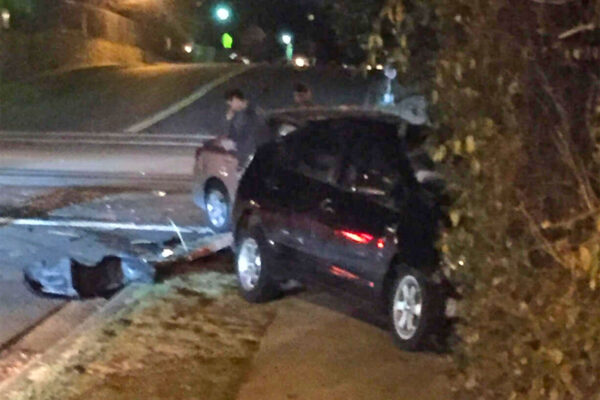
But since the new Lubber Run Community Center opened in July 2021, the problem has only gotten worse. Nearly half of those crashes have happened in just the past 19 months, statistics from the Arlington County Police Department show.
That includes another crash earlier this week.
@ARLnowDOTcom yet another crash at N. Park Dr. and N. George Mason. @ArlingtonVA how many accidents at this intersection before we get a light? Or are you waiting for a child to get hit first? This is right by the community center and school. pic.twitter.com/ZgcJB4zMyJ
— David (@Dhartogs) October 11, 2022
The county did add Rectangular Rapid Flashing Beacons (RRFBs) at the intersection in late 2020 as part of a transportation study related to the community center project.
“The intersection so far has not been identified as part of the Vision Zero High-Injury Network corridor or Hot Spot program,” DES said.
But this has not alleviated neighbors’ concerns. There’s a considerable worry that with increased pedestrian traffic, plus with Barrett Elementary School also nearby, it’s just a matter of time before a driver hits another pedestrian.
In other parts of the county, preventing pedestrian and bicyclists-involved crashes has been a significant ongoing concern amid a continued series of tragedies.
David Hartogs, who has lived in the townhomes across the street since 2005, told ARLnow he’s witnessed a “handful of crashes” and has heard at least another dozen at the intersection just over the last few years.
He recounted several of the crashes that stick in his mind most to ARLnow, including a car jumping a curb last spring, two accidents that resulted in vehicles ending up in the woods, and even a school bus “brushing” a motorcycle last November.
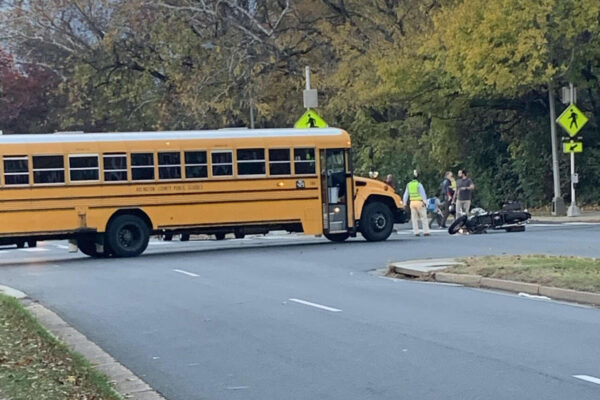
Earlier this week, Hartogs saw another crash and tweeted about his concern. As he noted on social media, he believes that there needs to be a traffic signal at that intersection and not just an RRFB.
He walks his kids to school and often thinks about their safety crossing that intersection.
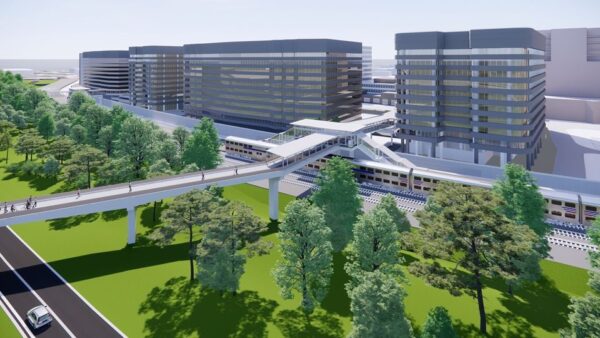
It’s a little less park-like than New York City’s High Line, but Arlington County has come up with a concept for new pedestrian bridge from Crystal City to National Airport.
Now, it is asking people to share their feedback.
Over the past year, the county, the Virginia Department of Transportation and a Boston-based civil engineering firm have evaluated 16 possible bridge and tunnel connections across active train tracks, the GW Parkway and National Park Service land.
After concluding the site could not accommodate tunnel entrances, VDOT and the county were left to consider two bridges. Today (Tuesday), Arlington launched a public engagement period for a preferred alternative, moving the needle forward on what’s being called the Crystal City to Ronald Reagan Washington National Airport Multimodal Connection project — or CC2DCA.
The county proposes starting the bridge at the planned Virginia Railway Express Crystal City station at 2011 Crystal Drive and ending in the second level of DCA’s Terminal 2 parking garage.
If built, it would take about five minutes to walk the 1,300 feet from the station to the airport, per a press release from the National Landing Business Improvement District.

The bridge would be an enclosed girder bridge running perpendicular to the rail tracks.
Then, the CC2DCA would run at an angle over the GW Parkway.
Initially, the county considered an arch bridge, but a bridge supported with girders would allow the county to link the connector with the Mount Vernon Trail without re-aligning it, per a staff presentation.
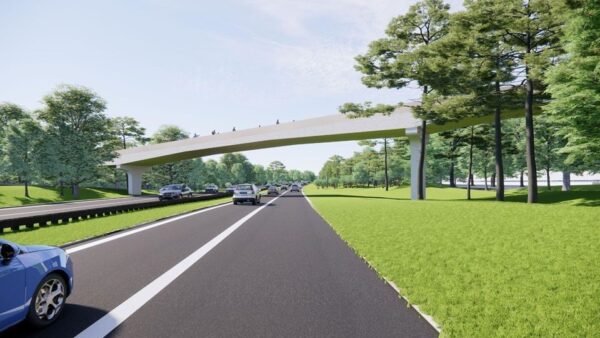
Once it links up with DCA’s Terminal 2 parking garage, pedestrians would have a dedicated walkway through the garage to the terminal. This path would eliminate 40 parking spaces, according to the presentation.
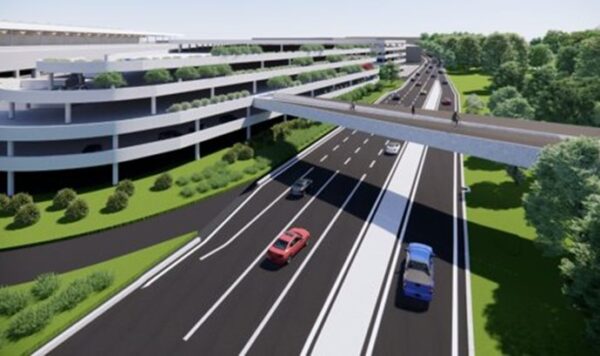
Ballpark estimates put the project at $43 million, the presentation said. So far, CC2DCA already has over $38 million in committed funds.
Now through Nov. 6, people can share their feedback in English, Spanish and Chinese, attend a public meeting on Tuesday, Oct. 25, or submit comments via email, according to the project webpage.
“The team is sharing concepts to make sure needs and priorities are aligned,” Dept. of Environmental Services spokeswoman Claudia Pors tells ARLnow. “This is the preferred recommended alternative to date, but it hasn’t been approved by any agencies as of now.”
After collecting public feedback, the county plans to present its recommendation to federal agencies in December, Pors said.
The preferred alternative could be confirmed by next spring and the design phase could start by the end of 2023, per the National Landing BID press release.
The second-place contender would have started at 2231 Crystal Drive and ended at the third level of the Terminal 2 parking garage. Staff ultimately decided against it because it was projected to cost $64.5 million, would eliminate 130 parking spaces at the airport and it would not be as centrally located for rail users, per the staff presentation.
Dog poop, a lackluster park and imposing tower façades.
These are lingering concerns for some county commission members and residents who recently reviewed designs for two proposed apartment towers from JBG Smith in Crystal City.
The developer proposes building two towers with a total of 1,440 apartment units where the restaurant Jaleo (2250 Crystal Drive) used to be, and where an 11-story office building stands (223 23rd Street S). The new towers would have ground-floor retail and a parking garage underground.
Architects went back to the drawing board after a meeting in July to improve designs, and generally, these improvements were welcomed during a Site Plan Review Committee meeting last week.
Still, commissioners, community members and county staff said a planned interim park should be more vibrant — with ample amenities to separate dogs and their droppings from other visitors — and the towers should have more pedestrian-scale architecture, so that walking by does not feel claustrophobic and shady.
“I do hope there will be signs saying ‘This is not a dog park’ because people will try their hardest to use it as such,” said Ben D’Avanzo, a nearby resident representing the Aurora Highlands Civic Association, during the meeting on Thursday. “There’s only so much we can do to control that and prevent what happened at Met Park happens here.”
Before Amazon began rebuilding the park, Metropolitan Park was best known for being a large patch of grass where dogs from neighboring apartment buildings relieved themselves.
The 2010 Crystal City Sector Plan envisions three park spaces, totalling some 26,000 square feet, but one of those parks would require JBG Smith to redevelop apartments at 2221 S. Clark Street. In the interim, as part of this project, JBG Smith will create a temporary 8,000 square-foot park on the southwest corner of 223 23rd Street S.
Commissioners had also criticized initial designs for the park near JBG Smith’s planned towers for being “just a lawn,” said Planning Commissioner James Schroll during a meeting last week.
“Some of the concerns we received from you guys is that there may be foot traffic cutting through this lawn and there were concerns pet owners would use it for dog relief, and we didn’t really want that,” said Amanda Walker, with OJB Landscape Architecture.
Landscapers added pet relief areas and plantings around the park’s edges to prevent people from creating desire paths. The park is designed to allow for flexible, removable furniture to accommodate concerts, fitness classes and picnics and become a “destination for the community,” Walker said.
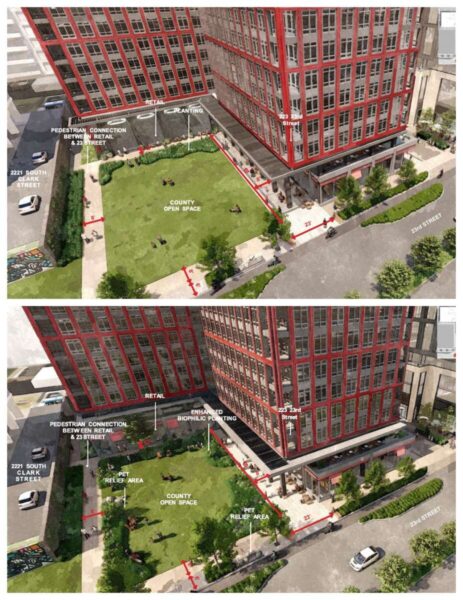
“Right now, this looks good, but we’ve got lots of parks that look like this all over the area. It’s going to be hard to attract people to it in this interim period,” said Michael Dowell, representing the Crystal City Citizen Review Council. “If we really want to take a chance, let’s get some massive sculpture — that you can move…”
“… to the next interim park,” said Chris Slatt, representing the Transportation Commission at the SPRC meeting, completing Dowell’s sentence.
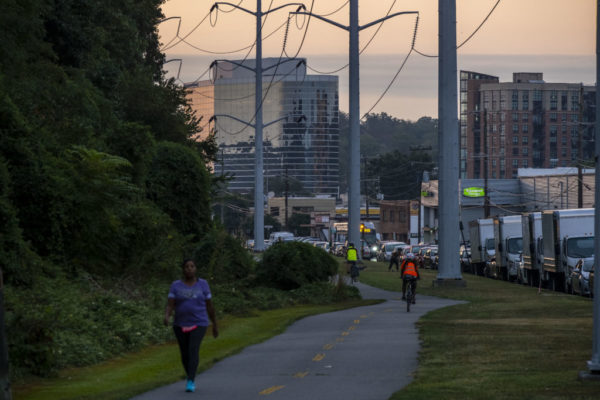
The Northern Virginia Regional Park Authority is looking to expand the W&OD Trail in Arlington, potentially by 2027.
The organization, also known as NOVA Parks, released its five-year strategic plan on Tuesday. The plan includes proposed upgrades to Arlington’s section of the Washington & Old Dominion (W&OD) Trail, including the addition of a dual-use trail.
Sometimes called “the skinniest park in Virginia,” the old railroad-turned-trail actually starts in Arlington, with mile marker zero in Green Valley near the intersection of S. Four Mile Run Drive and Shirlington Road. It extends about five miles running northwest through the county to Benjamin Banneker Park, continuing into Falls Church, and beyond.
About 2 to 3 million people use the trail each year.
NOVA Parks says it is aiming to “design and expand the capacity of the W&OD Trail in congested urban areas” including the Arlington section of the trail. That could mean a widening of the trail.
The design work for this expansion is expected to be completed within the next two years, per the plan. The work will be done in collaboration with the Northern Virginia Transportation Authority.
Plans will also be developed for sections of dual trail along the W&OD in Arlington, like what was completed in Falls Church last fall. Dual trails allow for separate pathways for bicyclists and pedestrians.
The idea was first brought up at the Falls Church ribbon-cutting in October 2021 and was embraced by many who bike, run and walk on the trail, which can get crowded during peak usage times.
There was some opposition to expanding the trail, however, including from current County Board candidate Audrey Clement, who decried a “massive uprooting of vegetation” and runoff from additional paved surfaces.
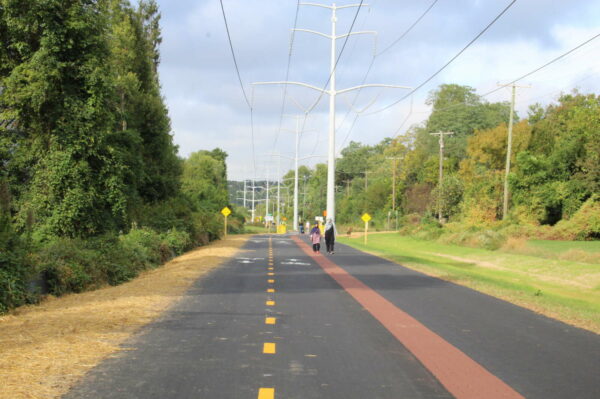
NOVA Parks Executive Director Paul Gilbert told ARLnow in an email that there’s grant money available to design something in Arlington that is similar to what’s now in Falls Church.
“The goal would be to do like we did in Falls Church and, where possible separate cyclists from walkers with parallel paths,” Gilbert said. “There may be areas where we just have room to make the single existing trail a little wider and other areas where users can have separate paths.”
In terms of when this might be built, that’s not clear with design work still needing to be completed. The hope is to bring those designs back to the community for feedback by 2024 and begin construction “when permits are approved.”
Overall, NOVA Parks is pledging to spend more than $6 million on creating and improving trails across the region over the next 5 years.
As the only regional park authority in Virginia, NOVA Parks encompasses 34 parks and manages 12,335 acres of land in six Northern Virginia jurisdictions, including Alexandria, the City of Fairfax, Falls Church, Fairfax County, Loudoun, and Arlington.
The strategic plan also promises a number of improvements, big-ticket projects, and expansion of Northern Virginia parkland over the next half-decade.
NOVA Parks is committing to planting 50,000 more trees, restoring native plantings to at least ten new areas, reducing parks’ carbon footprint by 2%, and expanding solar energy to three additional parks, all by 2027. The plan is also to start introducing electrical vehicles and mowers into its fleet by 2024.
Additionally, there are several big money items on the agenda. NOVA Parks is looking to acquire at least five new properties by 2027, as well as build a W&OD Trail Visitors Center.
The center is likely to be built in Loudoun County, Gilbert told ARLnow, near where a trail maintenance facility is currently located.
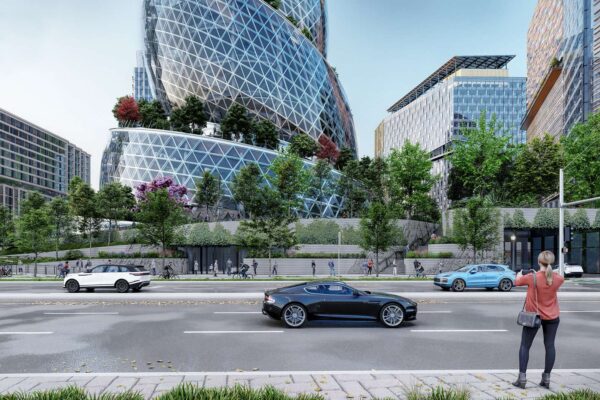
A major project to make Army Navy Drive in Pentagon City more bike- and pedestrian-friendly is expected to kick off later this year.
The Arlington County Board approved a $10.6 million construction contract for the long-planned “Complete Streets” project at its meeting this past Saturday.
“The project will rebuild Army Navy Drive within the existing right-of-way as a multimodal complete street featuring enhanced bicycle, transit, and pedestrian facilities and street trees,” said a Board report. “The goal of the project is to create a safer, multimodal system of connections between commercial, residential and retail services of the Pentagon City and Crystal City.”
Currently, Army Navy Drive is a 5-6 lane vehicle thoroughfare mostly serving those driving to the Pentagon, the Pentagon City mall, and nearby apartments, offices and hotels. The project seeks a more balanced mix of transportation modes while giving the corridor a more pedestrian-oriented feel.
“The reconstruction will provide a physically separated two-way protected bicycle lane facility along the south side of Army Navy Drive, in addition to shorter and safer pedestrian crossings, and will accommodate future dedicated transit lanes,” says the project website. “Vehicle travel lanes will be reduced in number where appropriate and will be narrowed to dimensions appropriate for a slower urban context.”
Plans show at least two vehicle lanes in each direction, though some intersections may be configured with two turn lanes and only one through lane.
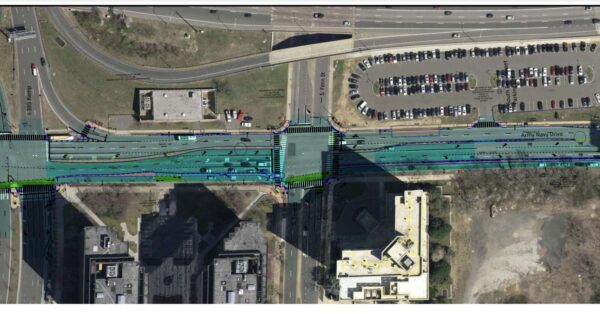
The project’s impending kickoff comes amid the continued construction of Amazon’s HQ2, the northern edge of which — including the iconic “Helix” building that’s part of HQ2’s recently-approved second phase — will border Army Navy Drive. It will also help facilitate the planned expansion of the Crystal City Potomac Yard Transitway and will serve a burgeoning residential population in the neighborhood, including a potentially expanded RiverHouse apartment complex.
More from the Board report:
This project will provide a key missing link in the County’s bicycle network by providing an east-west protected bicycle facility that will link up with the Mount Vernon Trail via the existing bike facilities along Long Bridge Drive and the proposed connection to be constructed by the adjacent Boundary Channel Drive/I-395 Interchange project. Furthermore, the project will link to the future two-way bicycle lane facility planned for South Clark Street between 12th Street South and 15th Street South, in addition to the future South Eads Street protected bike lanes.
This project will also complete the extended Crystal City Potomac Yard Transitway by adding one dedicated transit lane in each direction along Army Navy Drive between South Joyce Street and South Hayes Street. Finally, the Army Navy Drive Complete Street project supports multimodal connectivity goals of major planned and approved commercial and residential development in Pentagon City, including the Amazon HQ2, Met Park, and River House projects.
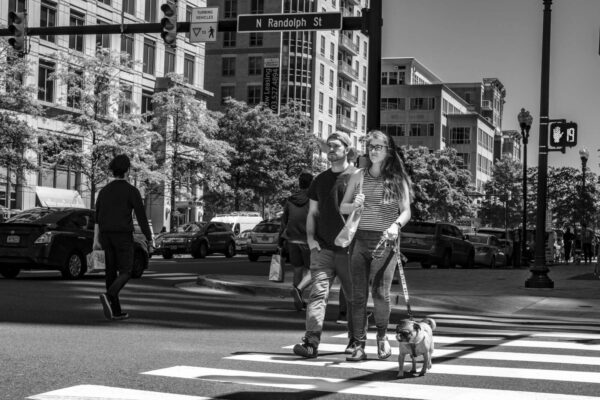
New York City. Portland. San Francisco. Seattle. And now Arlington.
Arlington County just joined the highest level “Walk Friendly Communities.” After previously becoming one of 15 U.S. communities to reach the program’s gold level, Arlington is now one of five at the platinum level.
More from a county press release:
According to WFC, the designation reflects Arlington’s success “in transit-oriented planning, remarkable promotion and outreach, and educational offerings for staff and residents.” It’s the first time the County has achieved platinum-level status from WFC after receiving a gold-level rating in 2010 and once again in 2015.
“Being recognized with a platinum rating by Walk Friendly Communities highlights Arlington’s ongoing commitment to increasing walkability throughout our neighborhoods,” said Arlington County Board Chair Katie Cristol. “We are committed, through many infrastructure projects and County-wide initiatives, to continuing to make walking a viable, enjoyable and safe way for both residents and visitors to get around Arlington.”
Arlington has 527 miles of sidewalks, more than 50 miles of paved, multi-use trails and 14.5 miles of hiking/natural trails. The County’s acclaimed multimodal Master Transportation Plan makes its Pedestrian Element a key feature in integrating growth around public transit lines, with special emphasis on sidewalks and multi-use trails.
Among its transportation outreach services, the County’s WalkArlington program offers abundant resources and events to encourage foot travel as a sustainable, healthy way to commute around and explore Arlington. One such effort is the more than two dozen highly detailed Walkabout map tours developed for discovering Arlington’s mix of neighborhoods as well as their unique features and histories.
In addition, an all-volunteer Pedestrian Advisory Committee helps County leadership and transportation planners visualize and achieve a more walkable Arlington through policy and infrastructure changes–from the busiest urban corridors to charming residential greenways.
An examination of the continued challenges faced by pedestrians is among the key components of Vision Zero, the County’s major transportation safety initiative to ensure that everyone traveling across Arlington arrives safely to their destination. In the first year of Vision Zero, almost 240 crosswalks were updated to display high visibility markings while speed limit zones around 13 schools were reduced to 20 miles per hour to protect walkers.
Four people died in crashes in 2021, the first year of Vision Zero. None of the fatal crashes involved a bicyclist or pedestrian.
While apples-to-apples comparisons are difficult given changes in driving and commuting patterns during the pandemic, Arlington has seen a decline in crashes — including those involving pedestrians and cyclists — from pre-pandemic levels.
The Walk Friendly Communities program is run out of the University of North Carolina and recognizes places that have “shown a commitment to improving and sustaining walkability and pedestrian safety through comprehensive programs, plans, and policies.”
“Managed by the University of North Carolina Highway Safety Research Center (HSRC), the program distinguishes communities leading the way in walkability and seeks to share their stories to inspire other communities to move toward their own innovative solutions,” the program website notes.
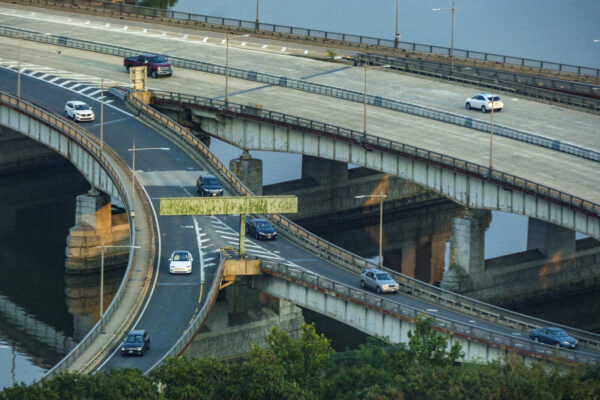
(Updated on 6/2) Wider sidewalks may be coming to a major Potomac River crossing.
The long-awaited rehabbing of the Theodore Roosevelt Bridge, one of the main thoroughfares connecting Arlington to D.C., will result in a new paint job, updated overhead lights, and significant widening of sidewalks, a new D.C. Department of Transportation report says.
Later this week, the National Capital Planning Commission will meet to approve a new report that focuses on much-needed repairs and rehabilitation of 58-year-old bridge that carries I-66 traffic over the river.
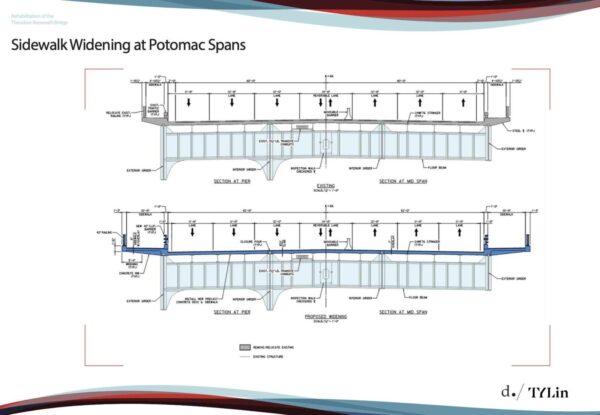
The report calls for the bridge to be repainted to its original white color, as well as for updating the overhead lighting and doubling the sidewalk width for pedestrians on both sides of the bridge. It notes that the current sidewalk widths, varying between four and six feet, “do not meet safety standards.”
Neither do the current barriers separating pedestrians from traffic, which are steel columns that are only a few feet high.
“The existing traffic barriers between the sidewalk and traffic lanes provide minimal protection from pedestrians and do not meet current safety standards,” says the report.
While the bridge is owned, operated, and maintained by DDOT, Arlington County has a significant stake in this rehab project considering that it’s one of the main connectors to D.C.
“TR Bridge has been a subject of discussion between our staff and DDOT for over a decade. Arlington has always strongly advocated for improving pedestrian and bicycle facilities on the TR Bridge,” Arlington County Director of Transportation Dennis Leach told ARLnow. “The existing conditions, both on the north side and south side, are pretty meager and really not up to current standards.”
There are also “long term goals” to further connect the sidewalks to more pedestrian-friendly thoroughfares.
On the north side, the walkway connects the Mount Vernon trail in Rosslyn to the Kennedy Center Reach ramp. However, on the south side, the sidewalk currently does not connect to any trail or pedestrian-accessible walkway. Leach acknowledges that taking the south side walkway from D.C. to Rosslyn the entire way currently ends in a dangerous place.
“You end up in the middle of the ramp system between Arlington Boulevard, Route 50, 110, and the Parkway,” he says.
The National Park Service, Arlington County, and the Virginia Department of Transportation are working together to look into the possibility of connecting the south side of the Roosevelt Bridge sidewalk to the Marine Corps War Memorial near Rosslyn, Leach notes.
He also brought up that beyond day-to-day traffic, the Roosevelt Bridge is a particularly important connection between Rosslyn and the National Mall, be it for emergency response or for special events like the Fourth of July. The entire bridge length is about 3,200 feet or about .7 miles, so it is short enough to walk and bike across.
“Currently, the sidewalk infrastructure is insufficient to provide good, safe connections between the National Mall and Rosslyn,” Leach says.
Despite it being unsafe, DDOT tells ARLnow that they are “not aware”of any pedestrian-related incidents or accidents within the bridge sidewalk.
In terms of repainting work that also will be done, that has more to do with “a cohesive aesthetic” than safety.
“Staff recommends that the Commission note that DDOT would repaint all structural steel on the Theodore Roosevelt Bridge to match its original white color designed to create a cohesive aesthetic between the bridge and nearby monuments and the Arlington Memorial Bridge,” reads the report.
Work isn’t expected to start for awhile, though. The project’s final design phase won’t completed for another year, a DDOT spokesperson writes to ARLnow in an email, until early summer 2023. At this point, it’s anticipated that construction will begin at the end of 2023 or early 2024 and will take four to five years to complete, the spokesperson said.
However, the sidewalk widening will be among the first elements of the project to be completed and could happen by the end of 2024.
Currently, DDOT is in the midst of “emergency repairs” that has shut down three lanes of traffic through at least June.
Nonetheless, Leach is confident that when the project does happen, the widening of sidewalks and adding better barriers separating pedestrians from traffic on the Roosevelt Bridge will make Arlington a more pedestrian-friendly place.
“We’ve talked about this project for over a decade,” he says. “These long term collaborations actually yield results. And I think this bridge rehab will bring a really good result for the District, Arlington and the region.”
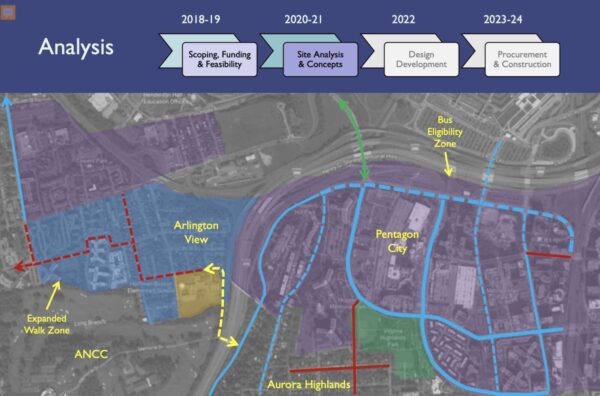
Nearly 30 years in the making, the Army Navy Country Club Trail Connector is closer to becoming a reality.
Construction on the long-proposed trail, a design for which has not yet been finalized, is expected to begin in spring 2024, officials say. Work could be completed the following spring, according to a recent county presentation.
The path for cyclists and pedestrians would run from a point near Hoffman-Boston Elementary and 13th Road S., in the Arlington View neighborhood, to Army Navy Drive near the I-395 overpass and the entrance to the club. It would provide a new way to get from Columbia Pike to Pentagon City.
The county is seeking community feedback on two preliminary concepts for the trail, which can be provided through the project’s website.
Final design will be completed in spring 2023, then there will be another opportunity for public feedback. By winter 2023, a contract should be awarded and an official construction timeline will be released, Project Manager Mark Dennis said.
Two preliminary concepts are being considered. One features high walls and a steep trail, which could cost $11 million. The other is defined by stairs and a runnel, and could cost $5 million.
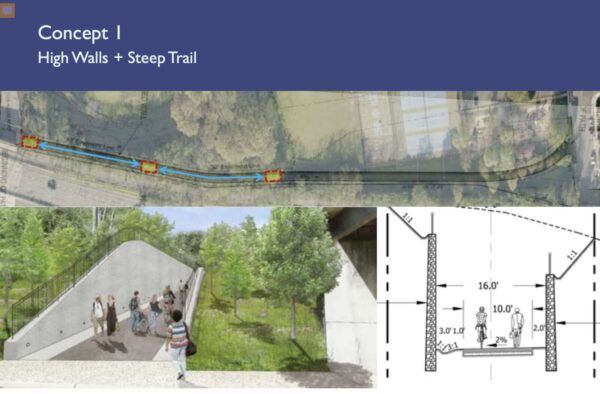
This first concept includes a 10-foot-wide, multi-use trail with a steep, 12% slope centered between retaining walls. The walls would run approximately 16 feet apart, and could be up to 16 feet in height.
Further design of Concept 1 would have to address the transition at Memorial Drive — the connector road leading to the club — where cyclists would have limited visibility to react to vehicular traffic.
Dennis compared the high walls and steep trail concept to the Custis Trail, which also has a 12% slope in some sections, he said.
“Any users out there who have taken the Custis Trail, you know what this feels like, it’s a great workout for those who are up to it,” he said. “It can be a little bit of a challenge for people who are just out for a simple walk or just want to get from A to B and not have such a vigorous bike ride.”
The second concept is a series of stairs and landings to manage the steep slope, and would feature a runnel, or wheel channel, for bicycles that could also accommodate strollers or carts.
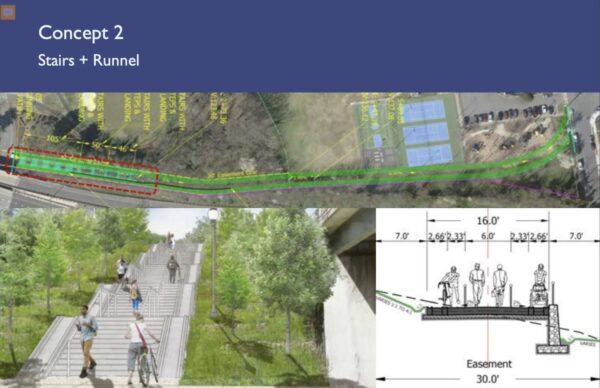
Several people raised concerns about accessibility for both concepts. Neither design features a winding, gradual slope, but the county has to work with what it’s got, Dennis said.
“The country club has very carefully considered our previous requests to expand the easement to grant more easement and they have respectfully declined,” Dennis said. “We are limited by the easement that we have and we have sufficient easement to accommodate concepts like the two I’ve presented.”
Those who have followed the project’s iterations may notice the easement’s shape has changed. After Arlington public safety officials rejected the emergency access road idea that was originally part of the project, the path’s endpoint near Hoffman-Boston shifted from S. Queen Street to the other side of the school, near the tennis and basketball courts, Dennis said.
Dennis said the project won’t be “all things to all people,” but the narrow, steep property will probably draw a “sort of self-selecting group of users,” he said.
“We hope it’ll be accessible for anyone who can climb stairs, we hope to be accessible for anyone who rides most kinds of bikes,” he said. “But we’re going to look at that very carefully in design and try our best to accommodate the broadest range of potential users.”
The project has been discussed since the early 90s and overcome many hurdles, including obtaining an easement from the country club, a resulting lawsuit from club members, the elimination of the emergency service road, and delays due to funding constraints.

